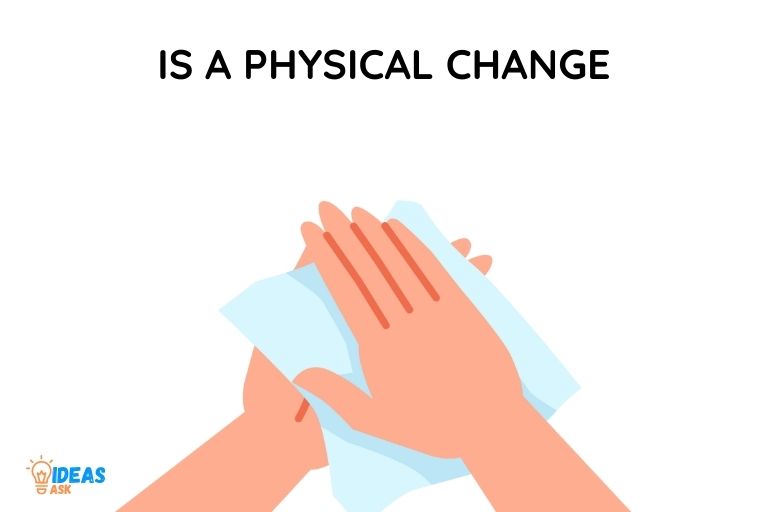Is Paper Towel Absorbing Water a Chemical Change? No!
No, paper towel absorbing water is not a chemical change; it is a physical change.
A chemical change involves a change in the molecular composition of a substance, whereas a physical change is a change in the physical properties without altering the molecular composition.
When a paper towel absorbs water, the water molecules get trapped between the fibers of the towel, but no new substances are formed. This process is considered a physical change as it only alters the physical properties of the paper towel.
When a paper towel absorbs water, the cellulose fibers within the towel create a network of microscopic spaces that can hold water molecules.
This allows the towel to effectively absorb and hold a significant amount of water. The process does not involve a chemical reaction, so it is considered a physical change.
Moreover, the water absorbed by the paper towel can be extracted by squeezing or evaporating, demonstrating the reversibility of the process, which is a hallmark of physical changes.
6 Properties of Water Absorption in Paper Towel
| Property | Chemical Change | Paper Towel Absorbing Water |
|---|---|---|
| Formation of new substance | Yes | No |
| Change in chemical composition | Yes | No |
| Change in chemical properties | Yes | No |
| Irreversible reaction | Yes | No |
| Mass change | Sometimes | No |
| Energy change (heat, light) | Sometimes | No |
Key Takeaway

Five Fascinating Facts about Paper Towel Absorbing Water as a Chemical Change
Physical Vs. Chemical Changes
Paper towels are a common household item used for cleaning spills and messes. Have you ever wondered when you soak up water with a paper towel, is it a chemical change or a physical change?
Let’s delve further and explore the differences between physical and chemical changes and determine which category paper towel absorbing water falls under.
Clear Definition Of Physical Change And Chemical Change With Examples
Physical changes refer to alterations in the physical properties of a substance, such as its shape, size, or state, without changing its chemical composition.
Examples of physical changes are:
- Cutting a piece of paper
- Freezing water into ice
- Melting chocolate chips
On the other hand, a chemical change involves the rearrangement of atoms and molecules, leading to a new composition and the formation of one or more new substances.
Examples of chemical changes are:
- Iron rusting
- Wood burning
- Digestion of food in the body
Clear Distinction Between The Two Types Of Changes
The difference between physical and chemical changes can sometimes be confusing.
The primary differences lie in the following:
- Chemical changes involve the formation of new chemical substances, whereas physical changes do not.
- Physical changes are often reversible, while chemical changes are typically irreversible or challenging to reverse.
- During physical changes, no new energy is released or absorbed, while chemical changes release or absorb energy.
Explanation That Paper Towel Absorbing Water Is A Physical Change, Not A Chemical Change
So, is paper towel absorbing water a chemical change? The answer is no. When a paper towel absorbs water, no new substances are formed, and the chemical composition of both paper towel and water remain unchanged.
Instead, the paper towel’s physical properties change, gaining moisture and expanding in size. This change is entirely reversible; if you squeeze out the water, the paper towel will return to its original form.
Paper towels absorbing water is a physical change and not a chemical change, as it does not involve a new chemical substance’s formation, and the composition of both water and paper towel remain the same.
It is important to understand the differences between physical and chemical changes to recognize and categorize various scientific phenomena, such as a paper towel absorbing water.
Why Paper Towel Absorbs Water
Paper towels are ubiquitous in modern-day households and are extensively used during cleaning. One common phenomenon we observe while using them is the absorption of water.
The extent to which paper towels absorb water interests scientists and also raises this intriguing question: is paper towel absorbing water a chemical change?
In this blog post, we’ll explore this question and understand the physical properties of paper towels responsible for their water-absorbing mechanism.
Explanation Of The Physical Properties Of Paper Towel Fibers
The paper towel is a combination of cellulose fibers and small spaces between them. The fibers are interconnected with each other, resulting in tiny air pockets known as interstitial spaces.
Some of the physical properties of these fibers include:
- The fibers possess a large surface area that makes them porous, allowing water to enter into the tiny spaces.
- Being hydrophilic, their surfaces have a high affinity for water molecules.
- The fibers are soft and loosely attached to each other.
Explanation Of Capillary Action And How It Allows Paper Towel To Absorb Water
Capillary action is the ability of a fluid to flow in narrow spaces owing to the combination of surface tension, adhesive and cohesive forces. The water molecules adhere to the fibers’ surface and flow through the spaces between them, leading to capillary action.
The paper towel’s fibers have a net negative charge that attracts positively charged water molecules, causing them to seep quickly through the fibers’ tiny spaces and get absorbed.
Paper towels can absorb water effortlessly because of their high porosity, interstitial spaces, hydrophilic nature, and capillary action. Next time you use them, marvel at their ability to absorb liquid effortlessly!
Experimentation And Evidence
Past Experiments That Prove Paper Towel Absorbing Water Is A Physical Change:
Several scientific experiments have been conducted in the past, providing evidence that paper towel absorbing water is a physical change.
This section lists some of these experiments, including key points that prove paper towel absorbing water is only a physical change –
- In an experiment conducted by high school students, they put wet paper towels inside a plastic container and sealed it. The result was that the paper towels still looked like paper towels. Ergo, no chemical change occurred in the process.
- Another experiment involved putting paper towels inside a beaker filled with water. The water moved up the paper towel and wetted it completely, but the paper towel still looked like a paper towel, without any visible chemical change.
Explanation Of Scientific Evidence And Reasoning To Support Paper Towel Absorbing Water Being A Physical Change:
The following points represent the scientific reasoning and evidence that prove paper towel’s ability to absorb water is a physical change –
- The physical properties of paper towel change when it absorbs water, but there is no change in the chemical structure of either water or the paper towel.
- The absorption process involves the movement of water molecules into the paper towel’s fibers, which causes the fibers to swell and open up to create space for water molecules.
- When we remove the absorbed water from paper towels by squeezing it, the physical properties of paper towels return to their previous state.
- An increase in weight when paper towels absorb water is due to the additional water molecules that the paper fibers trap, meaning there is no chemical reaction involved.
Scientific evidence proves that when paper towels absorb water, there is no chemical change. The change that occurs is only physical.
As water molecules move into the paper fibers, they swell and create space for the additional water molecules to be absorbed.
The absorption process changes the physical properties of the paper, but the chemical structure of both paper towels and water remains unaltered.
Applications And Importance
Explanation Of Why Understanding The Difference Between Physical And Chemical Changes Is Important.
One of the most fundamental concepts in science is the distinction between physical and chemical changes.
Understanding and being able to differentiate between these two types of changes is essential, as they play crucial roles in countless fields and applications.
Here are some reasons why understanding this distinction is important:
- Physical changes involve changes in a substance’s physical properties, such as size, shape, or state (e.g. From solid to liquid). These changes do not alter the substance’s chemical composition. On the other hand, chemical changes involve a chemical reaction that results in a new substance with different chemical properties.
- Understanding whether a particular change is physical or chemical is critical for predicting how the substance will behave under different conditions. This is particularly important in manufacturing and engineering industries where properties like strength, durability, and chemical stability are crucial.
- Understanding the different types of changes is crucial for scientific research, where it is important to know whether an observed change is due to a physical or chemical process. This knowledge is crucial in differentiating between the effects of physical and chemical factors in various experiments.
- In general, understanding these changes and their differences is critical to exploring and improving our understanding of the world around us.
Practical Applications Of The Knowledge – Such As In Science, Engineering, And Manufacturing Industries.
The knowledge of difference between physical and chemical changes has a broad range of practical applications across multiple industries.
Here are some examples:
- In agriculture, understanding the difference can help to identify how fertilizers will behave under different soil conditions (physical), versus how they will chemically affect the soil and crops in the long run.
- In manufacturing, knowing the differences helps to identify how physical and chemical treatments can alter the properties of materials, metals, and alloys, making them durable, heat-resistant, or corrosion-resistant.
- In the food industry, understanding the difference helps to identify how freezing or boiling will affect the quality of packaged foods (physical), versus how the chemical processes involved in cooking and baking can produce different flavors, textures, and colors in food products.
- In medical research, knowing the difference is crucial for determining how drugs and medications will interact with the body, considering both the physical behaviors and the chemical reactions that may occur.
Possible Misconceptions About Paper Towel Absorbing Water And Why Understanding The Truth Is Important.
There are several misconceptions that exist about the process of paper towel absorption. Understanding the truth is important for a number of reasons, including the field of materials science, development of improved products, and increasing environmental awareness.
Here are some possible misconceptions:
- One may assume that paper towel absorption is solely due to the towel’s pores and the spaces between the fibers. However, this is only part of the story – the paper towel fibers themselves are also responsible for absorbing water, due to a phenomenon called capillary action.
- Another misconception is that thicker paper towels are more absorbent than thinner ones. However, the thickness of the paper towel alone doesn’t guarantee absorbency – it is the combination of fiber density, type of fiber, and pore size that determine how much water the paper towel can hold.
- A third commonly-held belief is that paper towels are more environmentally harmful than other drying methods. However, this is not necessarily true. Studies have shown that paper towels have a smaller carbon footprint than high-speed hand dryers, and that recycled paper towels can be a more sustainable option.
Understanding these misconceptions and their realities is crucial for developing new paper towel products that are more effective and eco-friendly, as well as for making informed choices about their use.
FAQ About Paper Towel Absorbing Water
How Does Paper Towel Absorb Water?
The microscopic spaces between paper fibers in the paper towel act as tiny capillaries
that draw water upward against gravity, creating a wicking effect.
Does Absorption Of Water By Paper Towel Change Its Chemical Makeup?
No, the absorption of water by a paper towel is a physical change, not a chemical change. The water is held within the fibers of the paper towel and can be removed by squeezing.
What Prevents A Paper Towel From Tearing When It Absorbs Water?
The bonding of the fibers in the paper towel along with the expansion of the fibers
due to the absorbed water provide strength and prevent it from tearing during use.
How Can One Determine The Absorption Capacity Of A Paper Towel?
One way is to measure the mass of a dry paper towel, wet it with a known amount of water,
and then measure the mass again. The difference gives the absorption capacity of the towel.
Conclusion
Considering the above discussion, we can conclude that the process of paper towel absorbing water can be classified as a physical change rather than a chemical change. Paper towels are made up of cellulose fibers that can hold water through capillary action, which is purely a physical change.
Although the paper towel may become softer and weaker after absorbing water, the chemical composition of the paper towel remains the same. However, it is important to note that the use of chemical additives in paper towels can alter the absorption properties and may lead to a chemical change.
Overall, understanding the difference between physical and chemical changes can help us appreciate the science behind everyday objects and phenomena. We hope this article has provided an insightful look into the absorbing nature of paper towels and the science behind it.





